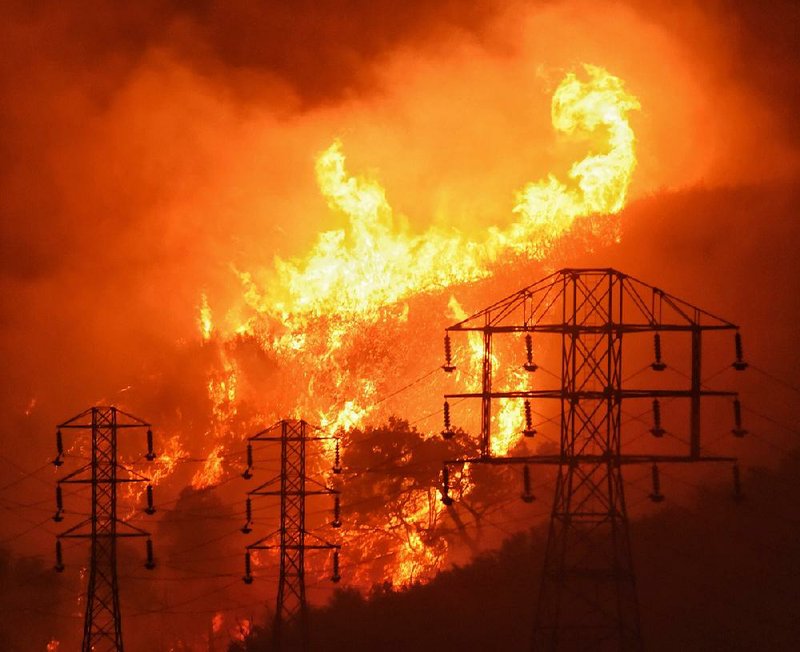California's property insurance market is feeling the effects of three-straight years of damaging wildfires. Insurers have pulled out of some markets and canceled thousands of policies, forcing regulators to step in and expand a state program that homeowners often turn to as a last resort.
Thousands of homeowners have lost their insurance policies and have been forced to scramble to find coverage from regular insurance providers or to turn to a government sanctioned plan that at the moment provides only fire coverage.
Kent Michitsch, 57, has lived in the same home northeast of San Diego for more than 30 years. He has received three nonrenewal notices in three years, and says he feared getting a fourth one when his homeowners' policy comes up for renewal the middle of next year if it wasn't for California lawmakers' recent intervention in the market.
"It's constant worry and frustration. You know you're covered now, but I might have to look for a new policy next year yet again." Michitsch said he has never made a claim on his insurance and never had fire damage.
While the insurance industry says the California property insurance market is resilient, state lawmakers and officials have had to scramble to keep the market from grinding to a halt from the unexpected additional risk.
The California Legislature passed a law earlier this year giving the Department of Insurance emergency powers to keep policies in effect for those in fire-prone areas. This month, Insurance Commissioner Ricardo Lara put a one-year moratorium on nonrenewals, in hopes that lawmakers, insurance companies and other stakeholders can reach a more substantial solution for the roughly 1 million homeowners in ZIP codes near previous wildfires.
"This wildfire insurance crisis has been years in the making, but it is an emergency we must deal with now if we are going to keep the California dream of home ownership from becoming the California nightmare, as an increasing number of homeowners struggle to find coverage," Lara said in a statement.
The fires of 2017 and 2018 caused a combined $25.3 billion in damage, according to the California Department of Insurance. That's exponentially higher than the previous wildfires in 2015 and 2008, which caused $1.1 billion and $719 million in damage.
The insurance industry has yet to release an estimate from this year's wildfire season, but the costs are expected to be high. The most significant wildfire this year was the Kincade fire, which started Oct. 23 and burned 78,000 acres in Sonoma County. It destroyed 374 buildings and damaged another 60, according to the California Department of Forestry and Fire Protection.
"The wildfires in California will likely make it more difficult for California homeowners to buy insurance," said Stu Ryland, senior vice president of the Pacific Region at Sedgwick, an insurance claims management company. "Premiums are likely to go up, particularly in areas that are prone to wildfires and in some cases, it may be difficult for consumers to find an insurer willing to write their insurance."
While some insurers are pulling out and others are reconsidering how they price property insurance, it is still available in one form or another to every homeowner, according to the Insurance Information Institute.
However, those not insurable by regular insurance providers are having to turn to what's known as the California Fair Access to Insurance Requirements Plan, a government-sanctioned association of insurers who pool together to cover the highest risk properties. The insurance currently covers only $1.5 million in damage, although Lara has ordered it to cover $3 million starting in April . Currently the plan covers only fire, not other forms of risk.
Earlier this month, the California Fair Plan Association sued to block those changes, arguing Lara's order is illegal.
Karl Susman, owner of Susman Insurance Agency in Los Angeles, says the average annual premium on a homeowner policy plus the access requirement to cover fire now costs around $2,500 a year, three times higher than it was three years ago.
"These wildfires are not sustainable for these companies. They aren't going to go bankrupt but they are just going to stop writing policies," he said.
Susman said he worries that without a longer-term solution the California insurance market will repeat the experience after the 1994 California Northridge earthquake, which caused many insurance carriers to stop offering earthquake insurance. He's already seen insurance companies limiting their risk to certain ZIP codes as well.
"I haven't seen anything like this in the 28 years I've been doing this," he said.
Fortunately, those who still do have insurance have been able to start rebuilding their lives after the fires.
Maggie and Dan London of Santa Rosa lost their home in the widespread, deadly Tubbs fire of 2017. They worked quickly after the fire, filing a claim and contacting their contractor that same day. But it took two years to rebuild and move back in.
Like many who tried to rebuild after the fire, they ran into obstacles -- higher costs for labor and materials and ongoing talks with their insurer. All the same, Dan London says his insurance company has done a fair job. And while they bought their home in 1979, he has not seen a sharp jump in insurance costs over time. The cost to insure their new home is slightly more, but London felt it reflects the increased value of the property.
"I was expecting something triple, but it's not at all," he said.
Business on 12/25/2019
